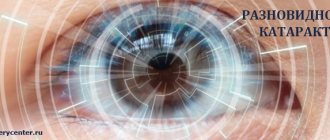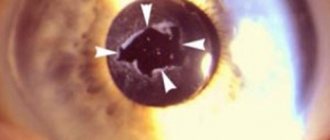Cataract is a progressive disease accompanied by complete or partial clouding of the lens. It is an optical lens responsible for the refraction of light rays. A clouded lens does not completely transmit light, which leads to deterioration in visual function. This disease develops in older people; the process can be long (10-15 years) and rapid, depending on the cause of the pathology. Usually the disease affects both eyes in turn. In the absence of timely treatment, and in some cases, surgical intervention, the patient may completely lose vision.
Development of the disease
Clouding of the lens does not occur all at once; this process has a clear staged nature and begins with minor and unnoticeable changes for the patient. The development of cataracts has its own speed, which depends on many factors - the characteristics of a person’s health, the presence of additional risks, and the functioning of the immune system.
Noticeable deterioration of vision occurs at the stage of transition of the initial form to immature cataract
. In this case, the pathological process affects not only the peripheral, but also the central parts of the lens.
It is important to understand that once a cataract is diagnosed, it will continue to progress, moving from an immature cataract to a mature form, gradually worsening vision. Unfortunately, there is no drug treatment that can prevent the progression of pathological changes.
Causes of cataracts
The lens is powered by intraocular fluid, which contains many elements. A change in the composition of this fluid provokes a metabolic disorder in the lens, which leads to the development of cataracts.
Possible causes of cataracts:
- injury;
- inflammatory process in the ocular system;
- heredity;
- hormonal treatment.
However, these factors increase the chance of developing the disease only under unfavorable conditions. These include smoking, chronic diseases, and poor nutrition. Under such conditions, the composition of the intraocular fluid necessarily changes.
Main symptoms
The clinical picture of the disease largely depends on the localization and extent of the process of lens opacification:
- Nuclear form.
Such immature cataracts require long-term preservation of visual functions and the transparency of the natural optical lens. However, symptoms also become noticeable - patients are bothered by “floaters” or spots, or light sensitivity. The danger of this form of the disease lies in the rapid progression of clouding - in just a month you can lose the ability to see clearly, up to complete loss of vision. - Cortical form.
The classic course of the disease is a gradual increase in symptoms, such as discomfort when trying to focus vision on an object, sensitivity to bright light, changes in color vision, fatigue, double vision, the appearance of rainbow circles before the eyes, and the sensation of a foreign body.
It is also important to understand that visual impairments are not corrected with glasses - changes become an obstacle to performing standard work or everyday activities.
Features of the initial stages of cataracts
- Maturing cataract
is characterized by the development of structural changes in the lens. In this case, vacuoles and cracks are formed, and the volume of the lens increases. If changes begin in the cortical zone, visual impairment practically does not bother the patient at this stage of the disease. With the nuclear form of the disease, vision may deteriorate from the first months. With cortical cataracts, the central part of the lens remains transparent for a long time. In this case, symptoms can vary from the sensation of “floaters”, the desire to rub the eyes, increased sensitivity to light to significant deterioration of vision. Presbyopes may experience some improvement in vision due to an increase in the curvature of the hydrated lens. However, this symptom disappears after some time, and vision again begins to progressively deteriorate. - Immature cataract
is a stage at which the opacities become more intense and their area increases. At the same time, vision gradually deteriorates. Blurred images, double vision, and a feeling of “veil” appear before the eyes. Sometimes an enlarged lens disrupts the circulation of intraocular fluid - phacogenic (phacomorphic) glaucoma develops. On examination, a decrease in the anterior chamber may be detected. As the cataract matures, visual vision decreases.
Treatment methods
Conservative and surgical methods for treating immature cataracts are known.
. Most often, patients are in a state of confusion after diagnostic measures; it is difficult for them to understand the seriousness of the problem, the need to operate the eye, and also decide to undergo microsurgical intervention immediately. Prescription of drug treatment by ophthalmologists is used as a way to slow down pathological processes and prevent the rapid transition of immature cataracts to mature ones. However, it is not possible to talk about the effectiveness of such treatment and it is clinically unproven.
Diagnostics
Methods to help make an accurate diagnosis:
- Eye pressure indicators
: they must correspond to the norm (except in cases of glaucoma); - Biomicroscopy
is a study using a special slit lamp that allows you to identify cavities of the transparent body filled with liquid. - Ophthalmoscopy
– analysis of the fundus. If the natural lens becomes cloudy, inspection will be difficult. - Perimetry
– measurement of viewing boundaries; with cataracts, the indicators are unchanged. - Ultrasound biomicroscopy
. Recognizes pathological changes in the lens. - Visometry
- visual acuity is determined using ophthalmological tables. - General ultrasound of the eyes
. Detects concomitant diseases. - Keratorefractometry
. A method that determines the elasticity of the cornea and determines visual acuity.
Additional tests are possible if there are concomitant diseases that can provoke the development of cataracts:
- Blood - general examination
: to identify the severity of the inflammatory process; - Rheumatological examination
: the disease may be aggravated by the presence of joint problems; - Blood sugar level
: diabetes mellitus is a catalyst for cataracts.
A patient with suspected disease can be referred to a phthisiatrician, endocrinologist, etc. according to individual characteristics.
Is surgery necessary for immature cataracts?
Previously, all schools of ophthalmology proposed the use of eye drops as a treatment for the initial stages of pathology, and only after a certain stage of cataract formation did specialists allow the possibility of surgery. This is due to the imperfection of microsurgical treatment methods at that time, invasiveness and the high risk of complications after surgical interventions.
Today, generally accepted protocols for the treatment of cataracts include mandatory surgical intervention.
. The need for surgical treatment as the only way to stop the pathological process of lens opacification has been scientifically substantiated. The operation consists of removing the affected lens of the diseased eye. Phacoemulsification of the cataract is performed, followed by implantation of an artificial intraocular lens, which successfully performs all the functions of the optical element of the human visual system.
The current level of development of laser and ultrasound techniques involves quick and painless removal of the lens
under local anesthesia, and a large selection of intraocular lenses allows you to choose a model that can fully compensate for all refractive errors and other visual problems.
Why do cataracts develop?
As a rule, the disease occurs due to the influence of one of the factors described below: Heredity. Genetically determined features of metabolic processes in the structures of the eye, including the lens, its sensitivity to environmental influences. A decrease in the rate of metabolic processes in the lens, associated with age, is the main genetically determined factor. During the aging process of the body, the composition of protein molecules changes (with an increase in the amount of insoluble proteins), the proportion of ATP and amino acids decreases.
External factors. These include: diseases, intoxications and exposure to ionizing radiation. These factors can also provoke the occurrence of the disease.
In its development, age-related cataracts go through the following stages of formation:
- Ripening.
- Immature.
- Mature.
- Overripe.
Drug treatment
Therapeutic methods are the use of local and general drugs that can prevent the rapid development of lens opacification. Immature cataracts stop progressing. Typically, such medications include antioxidant drugs and vitamin formulations - instillation of drops acts locally, and taking vitamin complexes in the form of tablets improves general metabolic processes in the patient’s body. Most patients are prescribed drug treatment for immature cataracts in the form of Taufon eye drops and similar products, as well as Okuwait vitamins. Most often, drugs are proposed to be used in complex therapy. However, surgery cannot be avoided in the end
. Modern surgery - phacoemulsification of cataracts can be performed even at the earliest stage of the development of the disease, and in some cases even with a completely transparent lens in order to correct myopia, farsightedness, astigmatism or presbyopia.
Cost of treatment for immature age-related cataracts
Prices for the treatment of immature age-related cataracts are determined based on the required volume of treatment and are calculated individually. The cost of phacoemulsification surgery in our ophthalmology clinic starts from 45,000 rubles (complexity category I, per eye). You can find out more information in the section Surgical treatment of cataracts or from the clinic administrators by calling: 8 (800) 777-38-81 (the call is free for mobile phones and regions of the Russian Federation). Opening hours: daily from 9:00 to 21:00, without lunch and weekends.
Prevention
Primary prevention of the disease includes a set of measures aimed at protecting the organ of vision from aggressive environmental factors, as well as normalizing metabolic processes - adhering to the principles of a healthy lifestyle.
It is important to undergo timely preventive examinations with an ophthalmologist at least once a year, as well as to treat all visual disorders - the development of cataracts in this case will be unlikely. If there are cases of lens opacification in the family, it is necessary to visit the ophthalmologist more often in order to identify changes in the early stages and correctly respond to pathological symptoms.
Prevention of the secondary form of the disease after cataract phacoemulsification surgery includes responsible adherence to all doctor’s recommendations, taking medications and strictly following the schedule of postoperative examinations with an ophthalmologist.
Types of cataracts in older people
forms of the disease are observed in an elderly person:
:
- Unilateral
type - disease of one pupil; - Bilateral
type - both eyes are affected at once.
The condition is also classified depending on its genesis as congenital or acquired. The congenital variant does not develop over time; Acquired disease is characterized by gradual progression. The acquired variety, in turn, can be traumatic, toxic, or radiation.
By place of origin
opacities cataracts are characterized as
- Nuclear
: pathology formed in the nucleus; - Cortical genesis
: the disease formed in the cortex of the transparent body; - Subcapsular
: the subcortical layers of the eye lens are affected.











